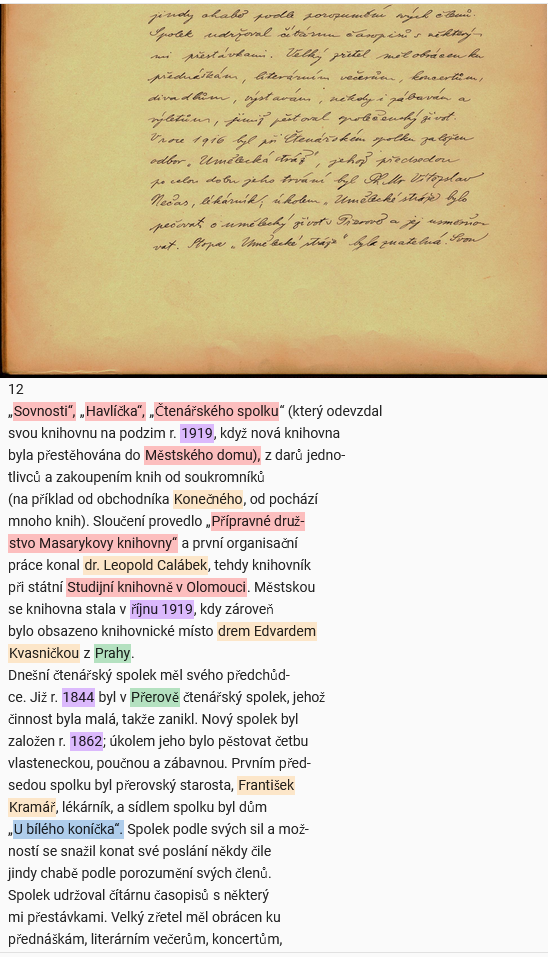license: apache-2.0
task_categories:
- token-classification
language:
- cs
tags:
- historical Czech
- Named Entity Recognition
size_categories:
- 10K<n<100K
configs:
- config_name: default
data_files:
- split: train
path: data/hugging_face/train/data-00000-of-00001.arrow
- split: test
path: data/hugging_face/test/data-00000-of-00001.arrow
- split: dev
path: data/hugging_face/validation/data-00000-of-00001.arrow
Dataset Card for PERO OCR NER 1.0
This is a dataset created for master thesis "Document Information Extraction".
Author: Roman Janík, 2023
Faculty of Information Technology, Brno University of Technology
Dataset Description
- Repository: PONER repository
- Paper: Document Information Extraction
Dataset Summary
This is a PERO OCR NER 1.0 dataset for Named Entity Recognition. The dataset consists of 9,310 Czech sentences with 14,639 named entities. Source data are Czech historical chronicles mostly from the first half of the 20th century. The chronicles scanned images were processed by PERO OCR [1]. Text data were then annotated in the Label Studio tool. The process was semi-automated, first a NER model was used to pre-annotate the data and then the pre-annotations were manually refined. Named entity types are: Personal names, Institutions, Geographical names, Time expressions, and Artifact names/Objects; the same as in Czech Historical Named Entity Corpus (CHNEC)[2].
Supported Tasks and Leaderboards
- Named Entity Recognition
Languages
The text in the dataset is in Czech, specifically historical Czech from the first half of the 20th century.
Dataset Structure
The CoNLL files are formatted as follows:
Each line in the corpus contains information about one word/token. The first column is the actual word, and the second column is a Named Entity class in a BIO format. An empty line is a sentence separator.
For detailed documentation, please see doc/documentation.pdf. In case of any question, please use GitHub Issues.
Data Instances
A data point consists of one sentence of text with corresponding NER annotation. An example from PONER Huggings Face dataset looks as follows:
{’id’: ’4138’,
’tokens’: [’Přednášel’, ’Frant’, ’.’, ’Pruský’, ’z’, ’Olomouce’, ’.’],
’ner_tags’: [0, 1, 2, 2, 0, 5, 0]}
Data Fields
id: data point idtokens: list of sentence wordsner_tags: list of entity types
Results
This dataset was used for training several NER models.
RobeCzech
RobeCzech [3], a Czech version of RoBERTa [4] model was finetuned using PONER, CHNEC [2], and Czech Named Entity Corpus (CNEC)[5]. All datasets train and test splits were concatenated and used together during training and the model was then evaluated separately on each dataset.
| Model | CNEC 2.0 test | CHNEC 1.0 test | PONER 1.0 test |
|---|---|---|---|
| RobeCzech | 0.886 | 0.876 | 0.871 |
Czech RoBERTa models
Smaller versions of RoBERTa [4] model were trained on an own text dataset and then finetuned using PONER, CHNEC [2] and Czech Named Entity Corpus (CNEC)[5]. All datasets train and test splits were concatenated and used together during training and the model was then evaluated separately on each dataset. Two configurations were used: CNEC + CHNEC + PONER and PONER.
| Model | Configuration | CNEC 2.0 test | CHNEC 1.0 test | PONER 1.0 test |
|---|---|---|---|---|
| Czech RoBERTa 8L_512H | CNEC + CHNEC + PONER | 0.800 | 0.867 | 0.841 |
| Czech RoBERTa 8L_512H | PONER | - | - | 0.832 |
Data
Data are organized as follows: data/conll contains dataset CoNLL files, with whole data in poner.conll and splits used
for training in the original thesis. These splits are 0.45/0.50/0.05 for train/test/dev. You can create your own splits with scripts/split_poner_dataset_conll.py. data/hugging_face contains original splits in the Hugging Face format. data/label_studio_annotations
contains the final Label Studio JSON export file. data/source_data contains original text and image files of annotated pages.
Examples
CoNLL:
Od O
9. B-t
listopadu I-t
1895 I-t
zastupoval O
starostu O
Fr B-p
. I-p
Štěpka I-p
zemřel O
2. B-t
února I-t
1896 I-t
) O
pan O
Jindřich B-p
Matzenauer I-p
. O
Label Studio page:
Scripts
Directory scripts contain Python scripts used for the creation of the dataset. There are two scripts for
editing Label Studio JSON annotation file, one for creating CoNLL version out of an annotation file and text files,
one for creating splits and one for loading CoNNL files and transforming them to the Hugging Face dataset format. Scripts are written in Python 10.0.
To be able to run all scripts, in the scripts directory run the:
pip install -r requirements.txt
License
PONER is licensed under the Apache License Version 2.0.
Citation
If you use PONER in your work, please cite the Document Information Extraction.
@mastersthesis{janik-2023-document-information-extraction,
title = "Document Information Extraction",
author = "Janík, Roman",
language = "eng",
year = "2023",
school = "Brno University of Technology, Faculty of Information Technology",
url = "https://dspace.vutbr.cz/handle/11012/213801?locale-attribute=en",
type = "Master’s thesis",
note = "Supervisor Ing. Michal Hradiš, Ph.D."
}
References
[1] - O Kodym, M Hradiš: Page Layout Analysis System for Unconstrained Historic Documents. ICDAR, 2021, PERO OCR.
[2] - Hubková, H., Kral, P. and Pettersson, E. Czech Historical Named Entity Corpus v 1.0. In: Proceedings of the 12th Language Resources and Evaluation Conference. Marseille, France: European Language Resources Association, May 2020, p. 4458–4465. ISBN 979-10-95546-34-4. Available at: https://aclanthology.org/2020.lrec-1.549.
[3] - Straka, M., Náplava, J., Straková, J. and Samuel, D. RobeCzech: Czech RoBERTa, a Monolingual Contextualized Language Representation Model. In: 24th International Conference on Text, Speech and Dialogue. Cham, Switzerland: Springer, 2021, p. 197–209. ISBN 978-3-030-83526-2.
[4] - Liu, Y., Ott, M., Goyal, N., Du, J., Joshi, M. et al. RoBERTa: A Robustly Optimized BERT Pretraining Approach. 2019. Available at: http://arxiv.org/abs/1907.11692.
[5] - Ševčíková, M., Žabokrtský, Z., Straková, J. and Straka, M. Czech Named Entity Corpus 2.0. 2014. LINDAT/CLARIAH-CZ digital library at the Institute of Formal and Applied Linguistics (ÚFAL), Faculty of Mathematics and Physics, Charles University. Available at: http://hdl.handle.net/11858/00-097C-0000-0023-1B22-8.
